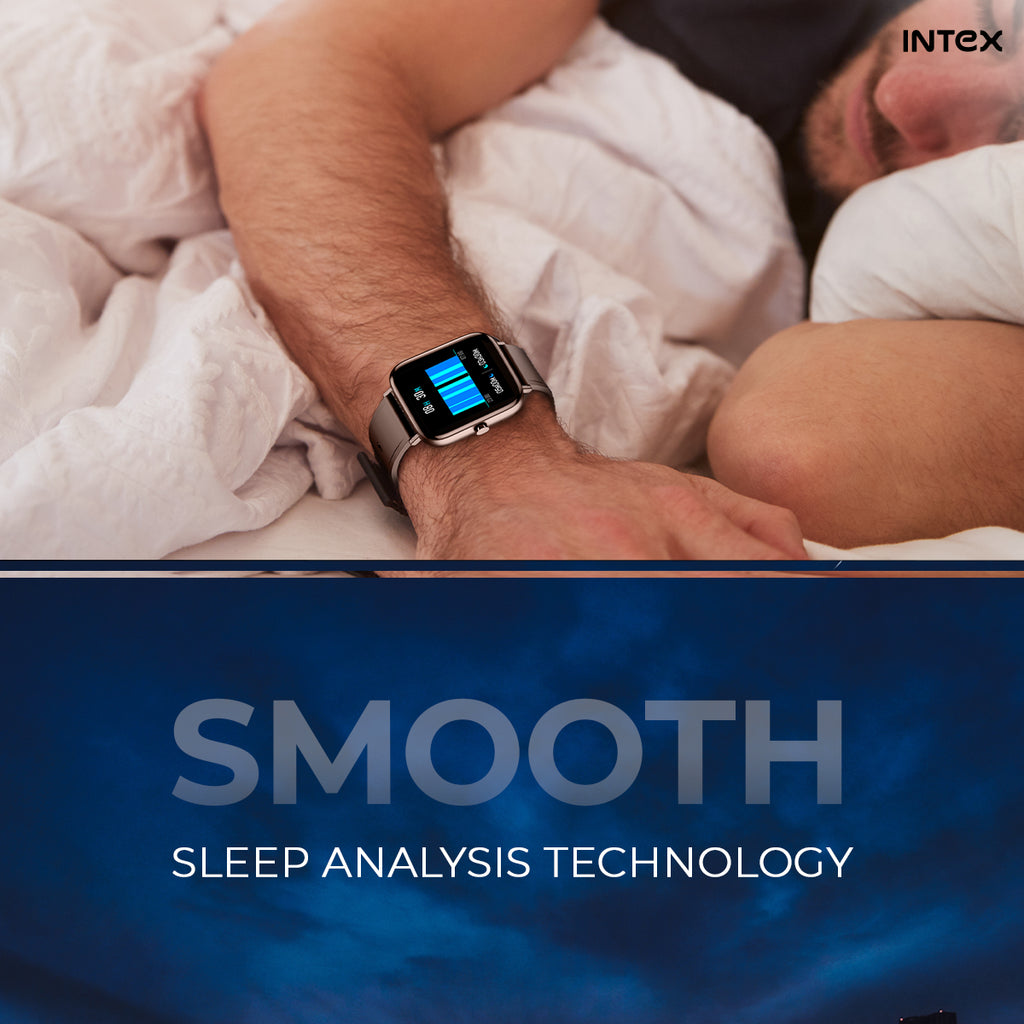Sleep Tracking in Smartwatches - Everything You Need to Know!
Posted by INTEX TECHNOLOGIES

Every smartwatch out there has some basic health and activity trackers. The smartwatches are equipped with heart rate monitors, BP monitors, SpO2 trackers, multiple activity trackers, stress trackers, and even sleep trackers.
Most people wear smartwatches all the time and use these to measure their sleeping patterns. But how safe is it really? And, should these be worn throughout? Does the radiation from these smartwatches affect our health if these are worn all the time?
Let’s discuss this below.
Getting enough sleep during the day is vital for our body to reset and get enough energy to carry on with the tasks of the next day. Sometimes our external circumstances do not allow us to rest fully and go in a deep sleep, which can cause sleep-related health issues that can have a negative impact on us.
This is where the sleep tracking feature of a smartwatch comes into the picture and through the various sensors tracks the different stages of our sleep. There are many other things that a sleep monitor on a smartwatch can take full account of. Let’s see a few below:
1. Sleep Quality: As discussed above, the time you are spending in each sleep cycle is what measures the quality of your sleep. A sleep tracker can tell you the number of times your sleep was interrupted and many other things.
2. Sleep Duration: By keeping a close record of the time you fell asleep and when you woke up, the sleep tracker can help you determine the numbers of hours you fell asleep for.
3. Sleep Phases: This tracking can also gauge our sleep cycles including rapid and non-rapid eye movement phases. So, what are the different stages of a human’s normal sleep cycle? Let’s discuss it in detail below:
a. Light Sleep – During this phase, one tends to wake up at the slightest sounds.
b. REM Sleep – In this stage, your body begins to relax and you tend to travel between light and deep sleep stages.
c. Deep Sleep – This stage is the most important as it helps your body relax, process your thoughts, and this is also when most physical recovery happens.
4. Sleep Environment: Some sleep trackers can also record the environment of your sleep and how comforting it is.
5. Lifestyle: Some sleep trackers also give you space to enter the various activities done by you during the day that allows them to measure the external factors that might or might not affect your sleep.
So how does a smartwatch track your sleep?
It is usually done using different methods such as actigraphy, which is movement detection or heart rate detection.
Actigraphy or wrist movement detection allows the band to detect your movement to track your sleep patterns. It primarily uses the gyroscope or accelerometer to track your movements and also detect which stage of the sleep cycle you are in.
Some smartwatches use heart rate sensors to monitor your heart rate reading. Your heart rate lowers while sleeping also varies when you reach the different stages in the sleep cycle. So, this data change helps the watch track and monitor your sleep cycle closely.
Now, you must be wondering that is it safe to wear a smartwatch or a fitness tracker all the time?
The simple answer is Yes. It is safe to wear a smartwatch all the time, but do keep note to take it off for a few hours to let your skin breathe and also to not let bacteria collect on your skin, below the watch.
If you want to understand your sleep pattern and track your sleep, then it is recommended that you do wear your smartwatch. Using the data, you can bring about a change as is required by either relaxing your body or getting proper sleep to stay calm.
Wearing one while sleeping can be a personal choice for every person. While some are used to it, others find it a tad too uncomfortable. The light behind the watch or the strap can sometimes lead to a disturbed sleep cycle. If you fall in this category then it is not advisable to wear a smartwatch as it can lead to a disturbed sleep cycle.
Some people are also concerned about the radiation that a smartwatch emits, which is also said to be radiated by smartphones, laptops, TVs; basically, most electronic devices. A smartwatch emits Electromagnetic Fields (EMF), which is low-frequency, non-ionizing, and does not have enough energy. A smartwatch usually sends signals in small bursts for a very short period of time. So, the radiation levels from a smartwatch are almost minimal! So, keeping your comfort in mind, you can wear a smartwatch 24*7. So, keep your hand with the smartwatch away from your head and you are good to wear it, even while sleeping.
However, not all is hunky-dory when it comes to wearing a smartwatch while sleeping. Let’s discuss in detail on what are the common issues and what are the precautions you can take.
1. Irritation on the Skin: Usually the straps of the smartwatches are made of material that can cause irritation and cause the skin to flare up if it is tightly wound around the hand or there is some residual water or sweat. To avoid this, you can loosen the strap while sleeping or if your smartwatch allows for changeable straps, switch it for a more comfortable one.
2. Constant Notifications – A smartwatch, when paired, gives you all your app notifications at one place, which results in vibration of the watch and that can create a disturbance while sleeping. To avoid this, make sure to switch to the DND mode of the watch or disconnect it from your smartphone to not get disturbed. You can reconnect it in the morning so that all your data gets synced.
3. Headache/ Health Issues – While there is no direct correlation between headaches and the radiation a smart watch emits, some people feel that there is a link between their health and the radiation that is caused. So, if you too feel the same you can avoid wearing a smartwatch at all. Or, you can wear it only for specific purposes like when going for a walk, doing some activity, or, while sleeping to track your sleep patterns.
So, we can conclude by saying that the smartwatch is an ideal accessory for you with its multiple trackers and health sensors. But, always take a precaution with it and keep removing it from time to time to let your wrist relax and skin breathe.

